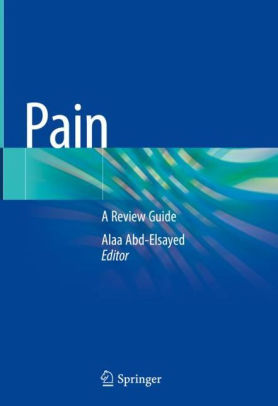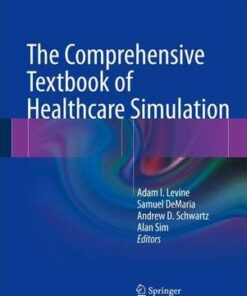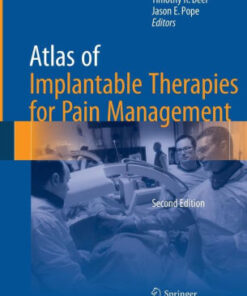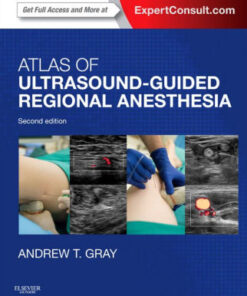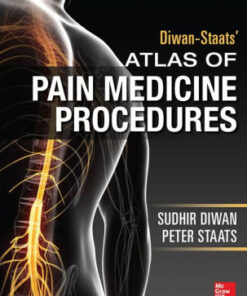(PDF) Pain – A Review Guide by Alaa Abd-Elsayed
$18.00
Download instantly Pain – A Review Guide by Alaa Abd-Elsayed. It is ebook in PDF format.
ISBN-10: 331999123X ISBN-13: 9783319991238
Preview
This is the PDF eBook version for Pain – A Review Guide by Alaa Abd-Elsayed
Table of Contents
1. Pain mechanisms and pathways.- Anatomy of the nervous system.- Sympathetic and parasympathetic systems.- Different types of pain.- Peripheral mechanisms.- Spinal and medullary dorsal horns mechanisms.- Segmental and brain stem mechanisms.- Thalamocortical mechanisms.- Experimental models.- Peripheral mechanisms of pain transmission and modulation.- Synaptic transmission of pain in the dorsal horn.- Central sensitization.- Neurotransmitters involved in pain modulation.- Development of pain behavior in the fetus and newborn.- Physiologic and behavioral pain assessment measures in infants.- Long-term consequences of neonatal pain.- 2. Research and study design.- Critical analysis of literature and evidence-based medicine.- Principles of valid clinical research.- Effects of analysis on the clinical applicability of study results.- Components of clinical trials.- Special features of study of pain.- Outcome measures in clinical studies.- Common animal models in the study of pain.- Ethics of animal experimentation.- Ethics of pain management and research.- Professionalism and quality assurance.- Placebo, Nocebo and Pain.- Use of data from epidemiologic studies of pain.- Measurement of burden in a population, including epidemiologic measures of occurrence.- Observational studies: uses and limitations.- Cohort studies: use to determine natural history and predictors of outcome.- Case control studies: uses, indications, limitations and design.- Use of risk factors to guide treatment.- 3. Assessment of Pain.- Pain as a subjective, multidimensional experience.- Introspection and measurement of subjective experience.- Measurement of pain (all scales for neonates, infants, children, adults and elderly).- Indirect pain measurement.- Dependence/tolerance/addiction/Abuse/misuse.- 4. Clinical Nerve Function Studies and Imaging.- Electrical nerve stimulation EMG/NCV.- Evoked potentials.- Quantitative sensory testing.- Skin punch biopsy.- MRI, fMRI, and MR spectroscopy.- PET scans.- EEG.- MEG.- X ray.- CT.- 5. Psychosocial and Cultural Aspects of Pain.- Pain as a biopsychological experience.- Individual differences in affective, cognitive, and behavioral responses to pain.- Coping styles.- Expectations, coping, cultural and environmental factors.- Cultural, environmental, and racial variations in experience and expression of pain.- Role of family in promoting illness and well behaviour.- Common emotional problems and psychiatric disorders associated with pain.- Sex and Gender Issues in Pain.- 6. Pharmacologic treatment of pain.- Opioids.- Antipyretic Analgesics.- Antidepressants.- Anticonvulsants.- Neuroleptic drugs.- Antihistamines.- Analeptic drugs.- Corticosteroids.- Muscle relaxants and antispasticity drugs.- NMDA antagonists.- Local anesthetics and membrane-stabilizing drugs.- Alpha 2 agonists.- Naloxone and Naltrexone.- Agonist/antagonist agents.- Ziconotide.- Marijuana.- Lidocaine infusion.- Herbal and vitamin supplements.- Fatty acids.- Capsaicin.- 7. Other methods for treatment of pain.- Cognitive and behavioral strategies.- Integration of approaches.- Stages of behavioral change and their effects.- Cognitive behavioral and self-management interventions.- Psychiatric and psychologic morbidities of chronic pain.- Psychiatric and psychological factors that impact treatment adherence and the therapeutic alliance with treatment providers.- Pharmacotherapy for treatment of comorbid conditions.- Psychotherapy for depressive disorders.- Differential diagnosis of anxiety disorders and their management.- Anger in chronic pain patients and relation to perceived pain.- Somatic complaints in chronic pain.- Role of family.- Role of patient beliefs and expectations in pain and disability.- Sleep disorders in chronic pain.- Work history and education in evaluation of chronic pain.- Peripheral stimulation techniques.- 8. Interventional Pain Management Including Nerve Blocks.- Anticoagulation.- Superficial and deep cervical plexus.- Stellate ganglion block.- Sympathetic blocks.- Brachial plexus.- Ulnar nerve.- Median nerve.- Radial nerve.- Femoral nerve.- Sciatic nerve.- Saphenous nerve.- Posterior tibial nerve.- Common peroneal nerve.- Superficial peroneal.- Deep peroneal.- Sural.- Lateral femoral cutaneous nerve.- Obturator nerve.- Ilioinguinal nerve.- Iliohypogastric nerve.- Genitofemoral nerve.- 9. Headache and Facial Pain.- Migraine headache.- Cluster headache.- Tension headache.- Other types of headache.- Botox injections.- Systematic case history.- Indications for further investigation of headache.- Physical, psychological, and social factors contributing to headache.- Occipital nerves.- Trigeminal nerve with all terminal branches.- Spheno-palatine ganglion.- Other ganglia.- Cranial nerves.- 10. Back.- Cervical Radicular Pain.- Neck Pain.- Thoracic radicular pain.- Thoracic back pain.- Lumbar Radicular Pain.- Low Back Pain.- Disc disease and discogenic pain.- PDPH.- Arachnoidtis.- Thoracic outlet syndrome.- 11. Musculoskeletal Pain.- Diagnostic labels for muscle pain.- Anatomy.- Multifactorial pathophysiology.- Common clinical characteristics.- Fibromyalgia.- Different muscle conditions.- Tendinosis and Tenditnitis.- TPIs.- TENS unit.- 12. Joints.- TMJ.- AA joint.- Sacroiliac joint.- Shoulder joint.- Elbow joint pain.- Wrist joint pain.- Hip joint pain.- Knee joint pain.- Ankle joint pain.- 13. Chest pain.- Anatomy.- Xiphodynia.- Costochondral junction, Costosternal junction and Intercosal nerve injections.- 14. Abdominal Pain.- Anatomy.- Causes and differential diagnosis.- Peripheral and central mechanisms of visceral pain modulation.- TAP block.- Celiac plexus block.- 15. Chronic Urogenital Pain.- Anatomy and epidemiology.- Clinical differentiation of gastrointestinal, urologic, gynecologic, and musculoskeletal pain.- Psychological principles in clinical assessment, explanation, and treatment.- Common causes, diagnostic evaluation, and treatment in men.- Common causes, diagnostic evaluation, and treatment in women.- Superior hypogastric plexus block.- Ganglion impar block.- 16. Surgical Pain Management.- Importance of general health status in preoperative evaluation.- Surgical lesioning of brain, brain stem, spinal cord, peripheral nerves.- Radiofrequency treatment.- Neurolysis.- Spinal cord and peripheral nerve stimulation.- Intrathecal drug delivery.- DRG stimulator.- Cordotomy.- Kyphoplast and vertebroplasty.- 17. Nerve conditions.- Complex Regional Pain Syndromes.- Phantom limb pain.- Peripheral neuropathy.- Other nerve conditions as mononeuropathy, mononeurpathy multiplex and others.- 18. Central pain.- Central pain.- 19. Cancer Pain.- Palliative care.- Hospice care.- Comprehensive evaluation of patients with cancer pain.- Principles of treatment.- Analgesic ladder approach.- Anesthetic approaches.- Surgical and interventional radiologic approaches.- Neurostimulatory approach.- Physical therapy.- Psychological approaches.- Needs of special populations.- Benefit to burden ratio.- Anorexia and cachexia associated with cancer.- 20. Pain in Pregnancy and Labor.- Factors influencing the perception of pain in pregnancy compared with the non-pregnant state.- Causes of pain and principles of pain management in pregnancy.- Mechanisms, characteristic, benefits, consequences and management of labor pain.- 21. Acute Pain.- Epidemiology of inadequate control.- Physiologic and psychologic effects.- Pharmacologic properties of major classes of drugs used for acute pain management.- Comprehensive plan for optimal perioperative pain management.- Non-pharmacologic treatment.- Clinical outcomes to be evaluated.- Tools for assessment and measurement.- Role of patient and family education.- Treatment of nonsurgical pain.- 22. Physical Medicine and Rehabilitation.- Temperature modalities.- Manipulation, mobilization, massage, traction.- Casting and splinting.- Exercise therapy.- 23. Work Rehabilitation.- Importance of early intervention and early return to work in reducing absence.- Psychosocial factors as the main determinants of disability.- Identification of obstacles to recovery.- Components of successful comprehensive rehabilitation program.- Multidisciplinary approaches for those who do not return to work within a few weeks.- Functional Capacity Evaluation.- 24. Complementary Therapies (CAM).- CAM.- 25. Clinical States: Taxonomy.- IASP classification of chronic pain syndromes.- Application and definition of pain terms.- 26. Pain in special population.- Pain in Infants, Children, and Adolescents.- Pain in older adults.- Delirium in the elderly.- Pain Issues in Individuals with Limited Ability to Communicate Due to Neurocognitive Impairments.- 27. Pain Relief in Persons with Substance use and Addictive Disorders.- Biopharmacologic and neurophysiologic basis of addiction.- Interactions between addiction and pain.- Screening for substance use disorder or addiction in patients with pain.- Principles of comprehensive approach to pain management in patients with addiction.- Pharmacologic treatment of patients with addiction.- Acute pain management of patients with active addiction or in recovery.- Analgesic response to opioids in patients with addiction.- Risks and benefits of opioid use in treatment of chronic/cancer pain in patients with substance use disorder.- Needs of special populations.- Legal, regulatory, reimbursement issues limiting access to care for patients with pain and addiction.- Treatment of withdrawal.- List of addictive drugs and their metabolites in urine.- Impact of alcohol use on pain.- 28. Pain Relief in Areas of Deprivation and Conflict.- Variability of availability and access to adequate pain treatment worldwide.- Causes of pain worldwide.- Spectrum of providers caring for patients with pain worldwide.- Limitations of education, training, and knowledge of pain and its treatment.- Research.- Inadequacy of access to drugs and palliative care in many countries.- 29. Other conditions.- Rheumatoid arthritis.- Osteoarthritis.- Osteomalacia.- Systemic lupus erythematosus.- Scleroderma.- Polymyalgia rheumatic.- Multiple sclerosis.- Post-polio syndrome.- Guillian Barre syndrome.- Ankylosing spondylitis.- Dupuytren’s contractures.- Neuromas.- PHN.- Syrngomyelia.- Serotonin syndrome.- Erythromelalgia.- Restless leg syndrome.- HIV/AIDS.- Sickle cell anemia.- Vascular/Claudications.- 30. Exam taking.- Exam taking.
